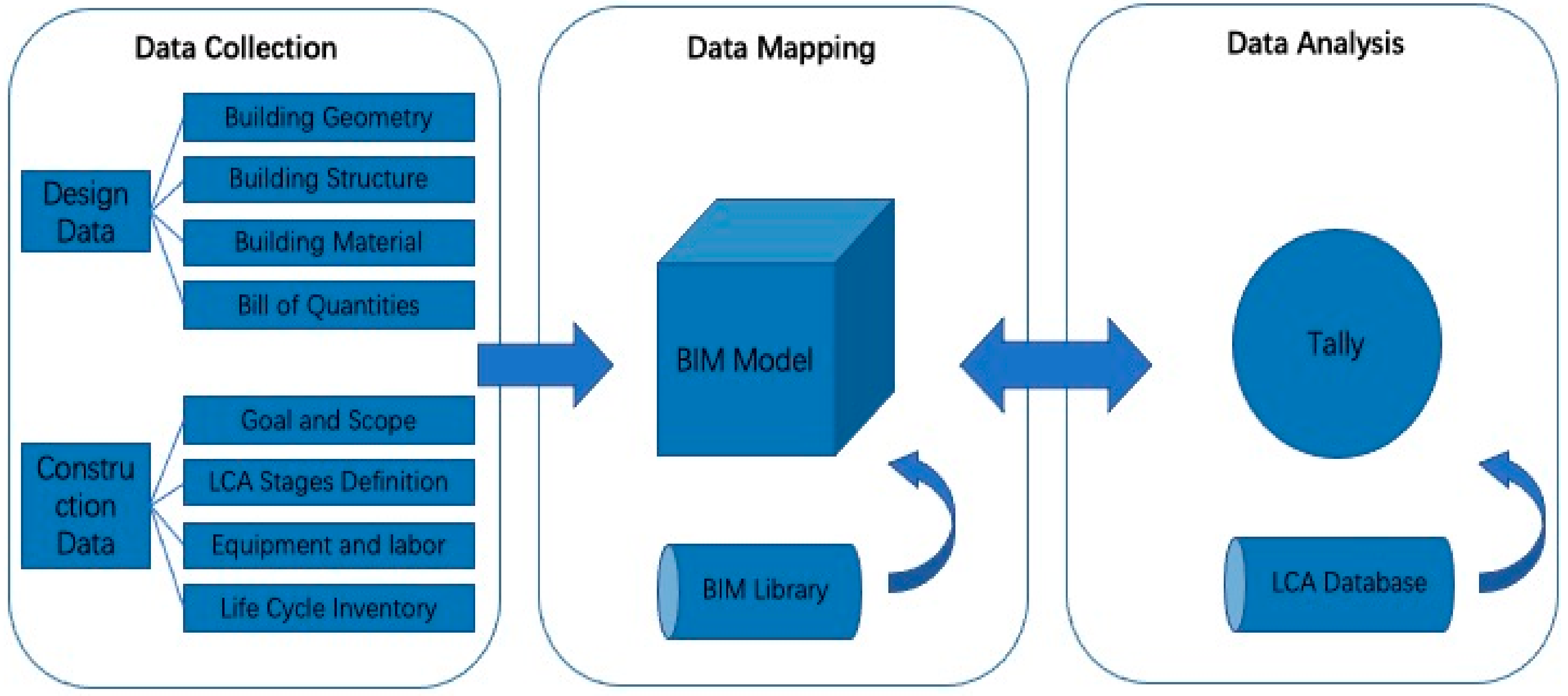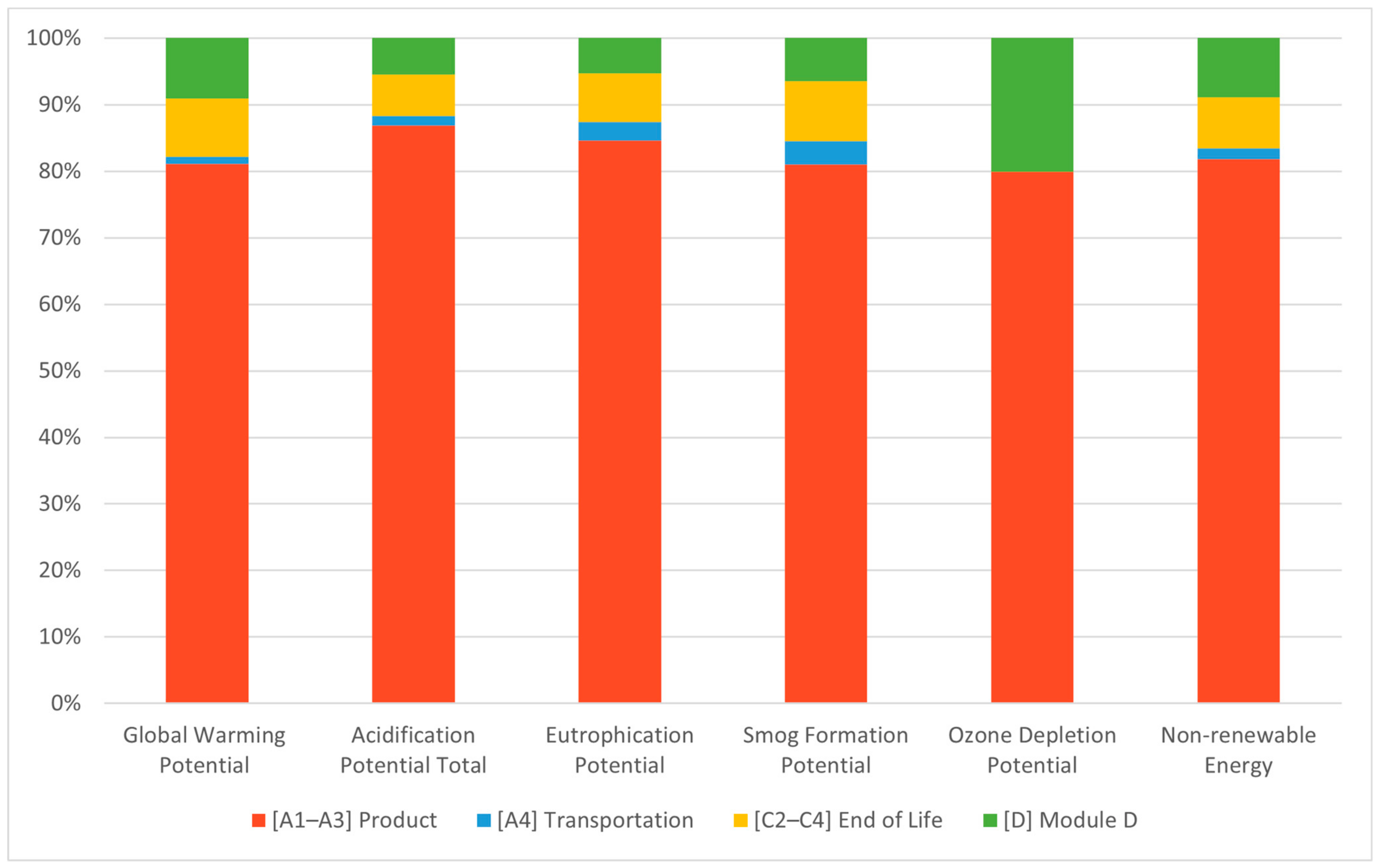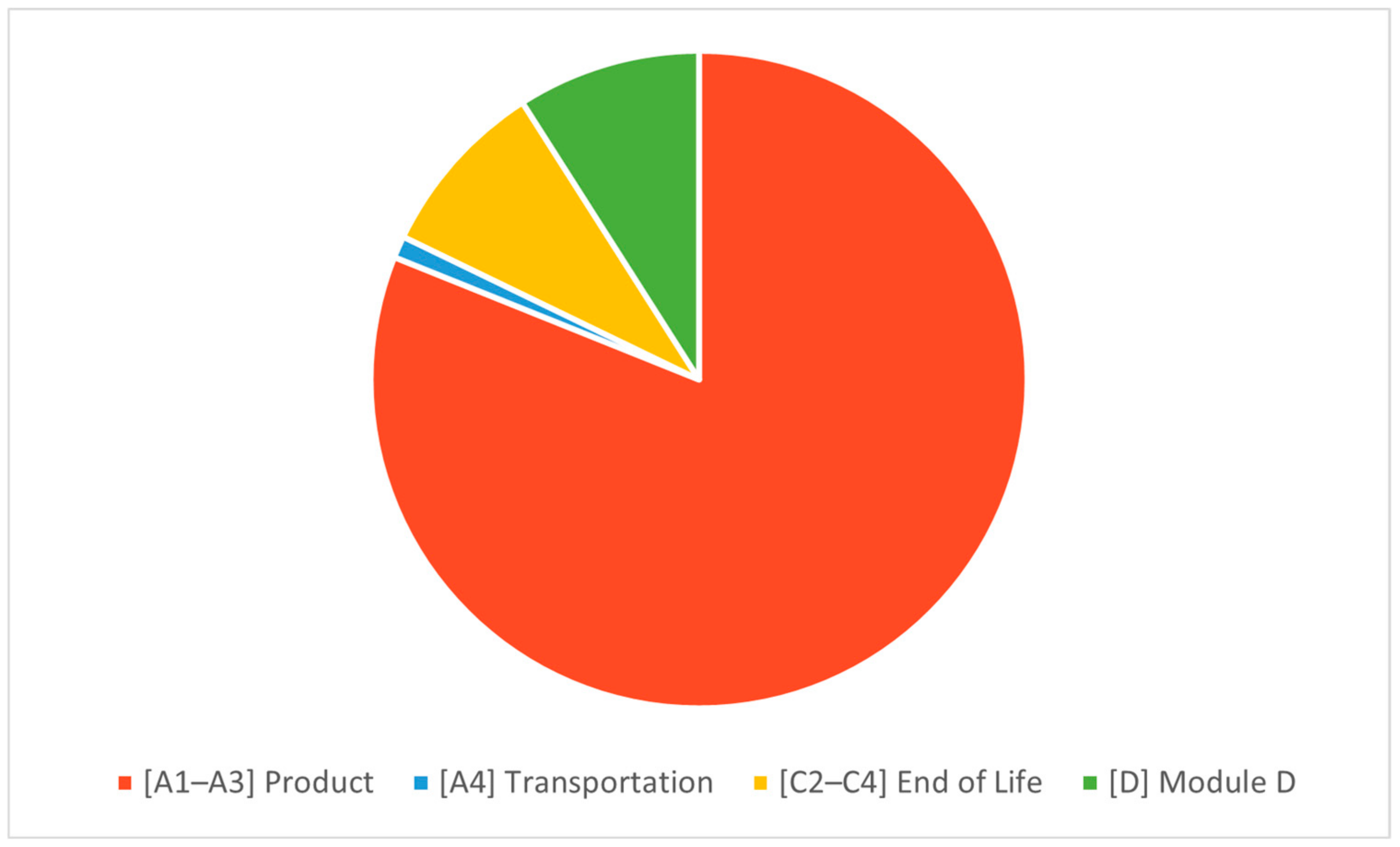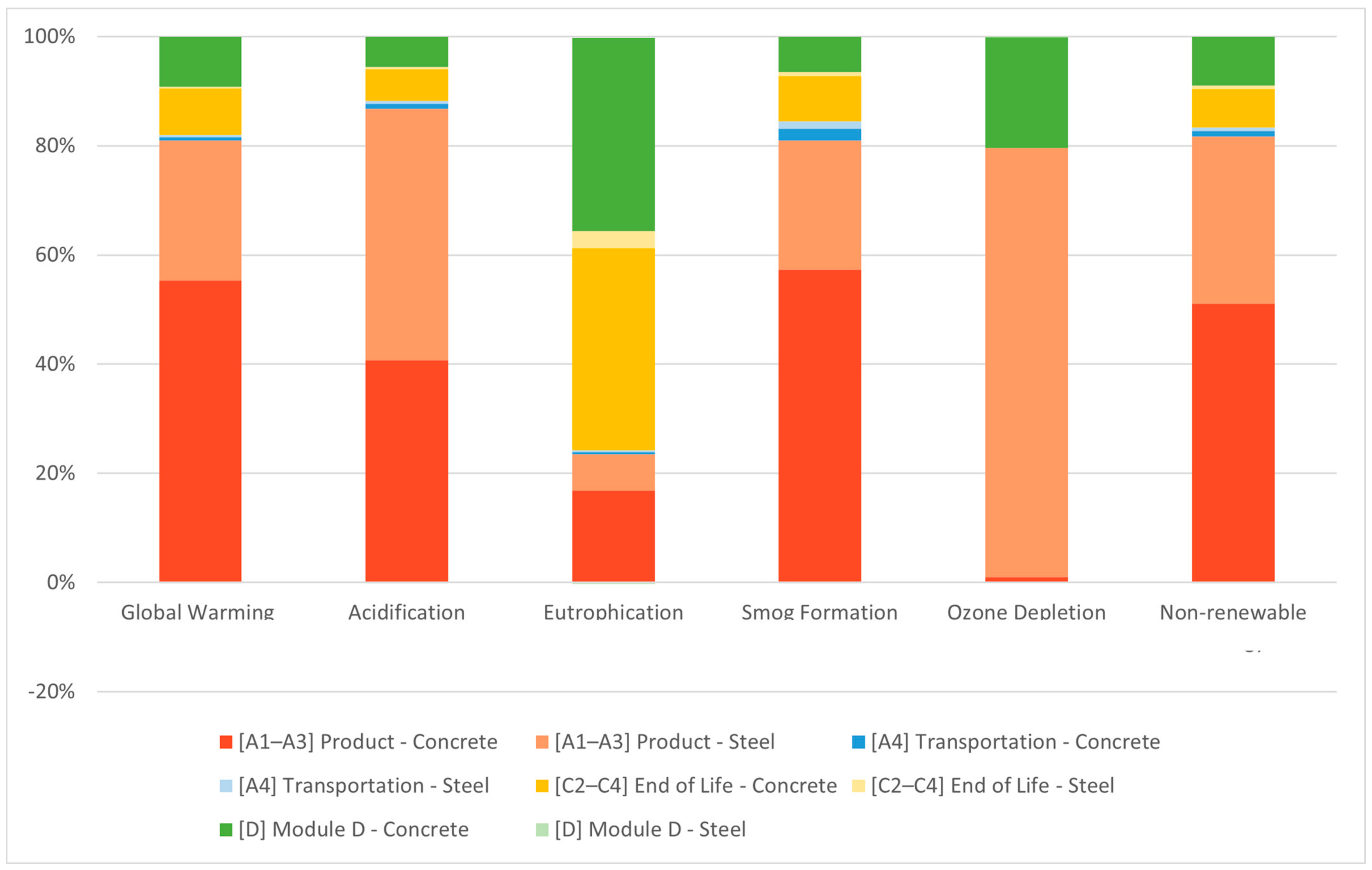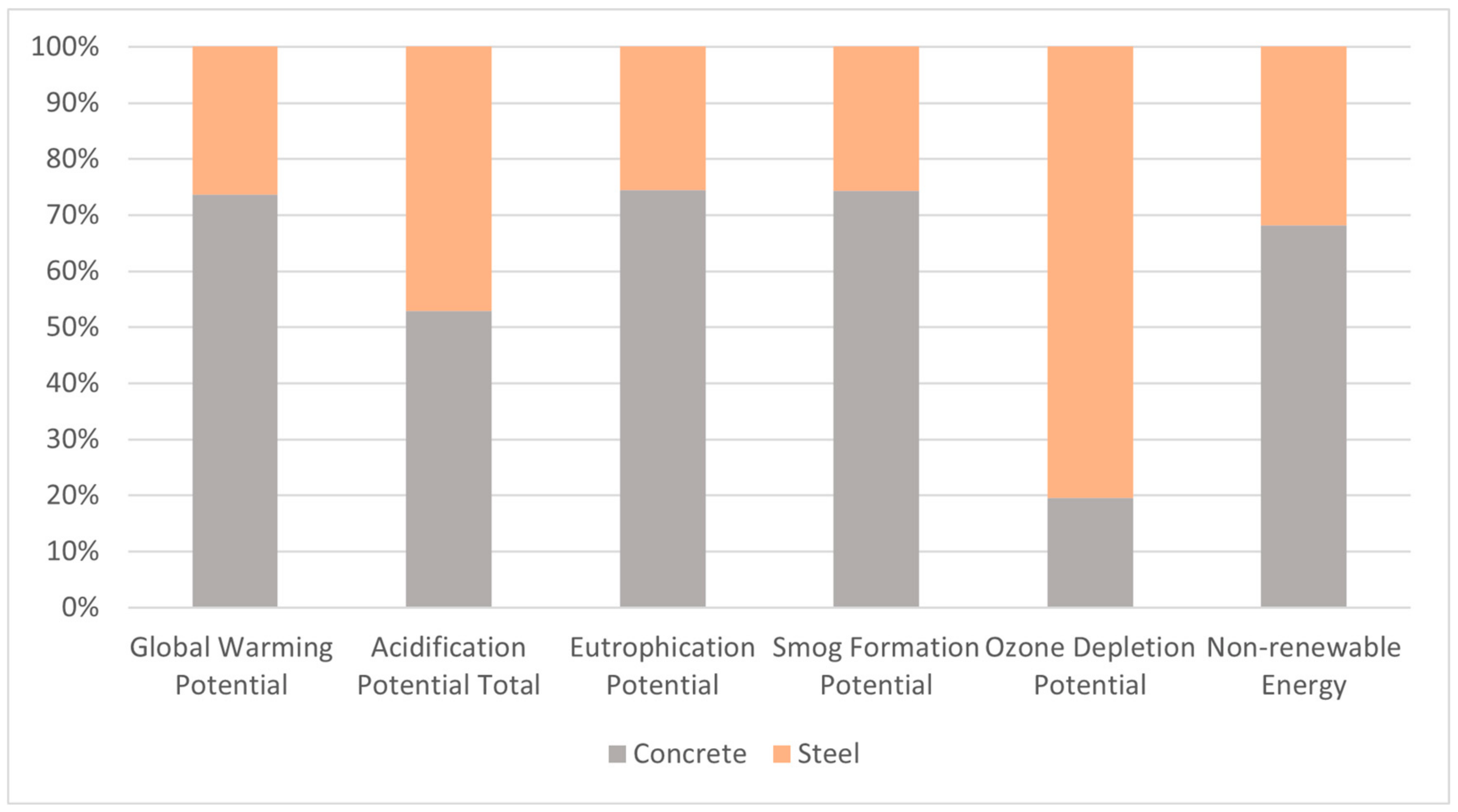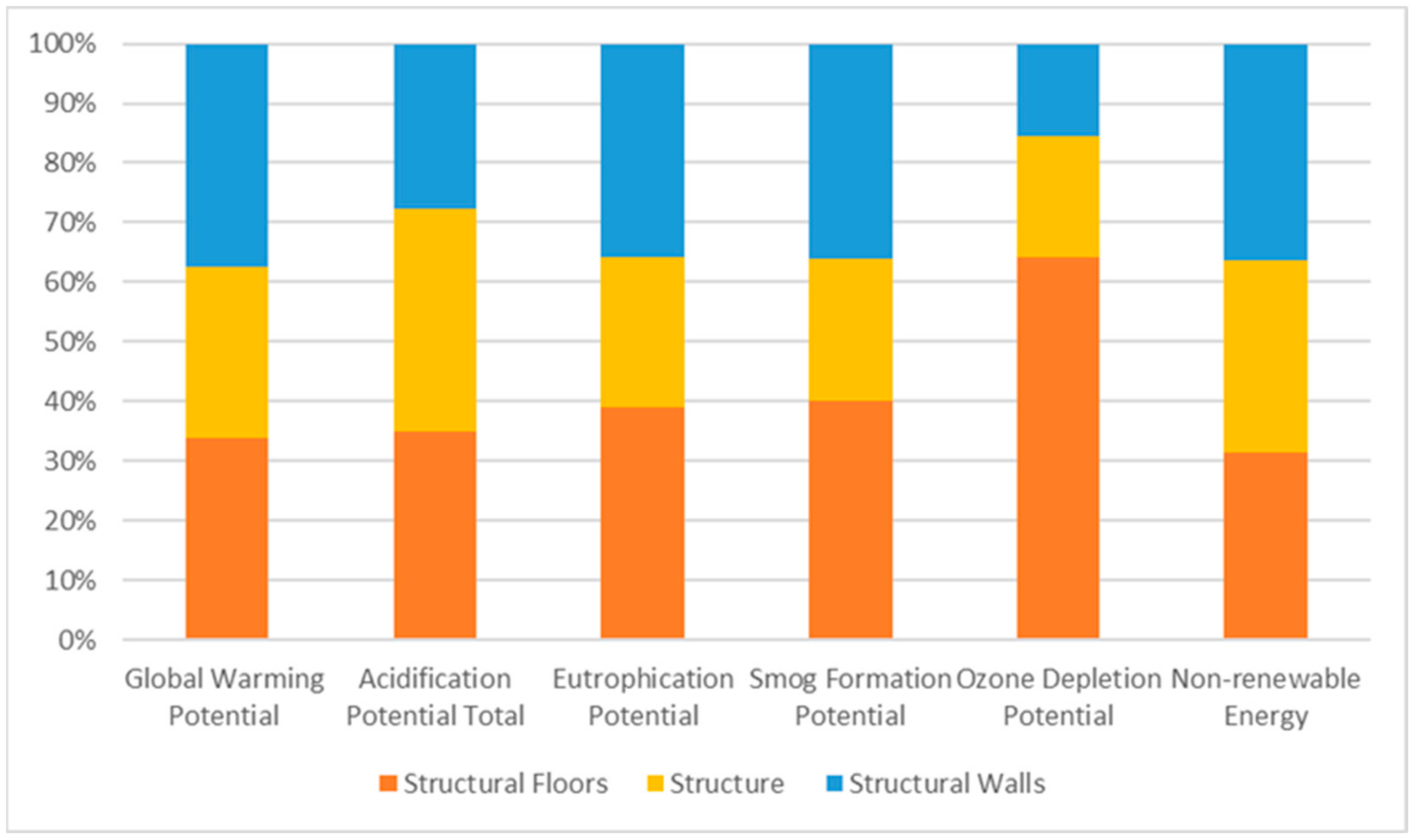1. Introduction
Global warming is one of the most paramount challenges facing our planet, and its carbon dioxide indicators are experiencing a rapid and concerning rise [
1]. The construction industry is recognized as a key driver of global warming through its contribution to 42 percent of primary energy consumption and 39 percent of global greenhouse gas (GHG) emissions [
2,
3]. With the increase in urban population and the stress due to land scarcity, a greater number of high-rise buildings are built globally to optimize land use. Denser urban landscapes are also considered a means to lower urban building energy consumption [
4]. Nevertheless, it is worth noting that high-rise buildings are generally associated with higher energy use and material demands per unit of floor space compared to low-rise buildings [
5], which in turn leads to projections of an elevated overall energy usage and greater emissions of GHGs associated with the construction sector.
The primary structural materials used in high-rise buildings are reinforced concrete and structural steel. As of today, over 99% of tall buildings’ structures are built from those two materials. This article focuses on the embodied carbon and other life cycle environmental impacts of high-rise buildings as a largely overlooked research area, particularly when compared with low- and mid-rise buildings, by studying a case study of a reinforced concrete high-rise building. The embodied carbon and environmental impact assessment of high-rise buildings is conducted using the LCA methodology, which relies on design and construction data as well as inventory data-intensive approaches. The dominant LCA approaches for such studies include Input–Output (I–O) LCA, process-based environmental LCA, or hybrid methods that take advantage of the strengths of both methods. Additionally, while many studies [
6,
7,
8] use software tool platforms for inventory data collection and LCA analysis, there are also some [
9,
10,
11] that follow computation procedures. For example, Gan et al. [
9] estimate major types of greenhouse gas (GHG) emissions by multiplying the material quantities by emission factors and then aggregating the results into global warming potential (GWP) [
9]. The limited availability of the inventory data for the unique context of high-rise construction challenges the current literature on LCAs of high-rise buildings. When data are available, the integration of building information modeling (BIM) and LCA methodologies can alleviate the challenge and help inform rigorous LCA studies on buildings. While various studies have underscored this potential [
12,
13], studies that use a comprehensive cradle-to-grave BIM-based tool for environmental sustainability simulation remain limited in number and scope [
14]. Aiming to cover this gap, the present article integrates Revit with Tally [
15], the first LCA add-on tool for Autodesk Revit, to quantify the environmental impacts of buildings utilizing the LCA approach based on a comparative digital model of the building. Tally is fully integrated with Revit and connects modeled BIM elements to quantities of real material in assemblies, including information from the manufacturer’s Environmental Product Declarations (EPDs).
There has been a noticeable pattern in the built environment literature in the past few years to use BIM for LCA [
16,
17]. Cavalliere [
18] reviews research on building LCAs and shows that 7 out of 28 commercial tools use a BIM model. Researchers have also developed workflows to connect LCA inventory modeling databases such as SimaPro with a BIM software such as Autodesk Revit [
19] or ArchiCAD [
20]. The key goal of this article is to assess the life cycle environmental impacts of a high-rise building structure in Chicago by applying the LCA methodology in the BIM environment. For this purpose, we use Tally as the LCA tool and Autodesk Revit as the BIM tool to estimate the embodied carbon and other environmental impacts of a high-rise building structure constructed with reinforced concrete as the case study. The scope of this article focuses on embodied stages while excluding operational stages. Two limitations are involved in this article. Firstly, the research is limited by the availability and quality of data in life cycle inventory (LCI) databases. For example, the GaBi LCI database used in this research is continuously improving, yet still has variability in emissions factors. This is because production processes for certain chemicals can vary greatly across suppliers in terms of emissions treatment. Therefore, the data values may not accurately represent emissions from a given supplier. Secondly, as a data-driven tool, the level of complexity and confusion involved in collecting and analyzing data will always be a limitation.
The key objective of this study is to understand the primary factors contributing to reinforced concrete high-rise building structures’ embodied carbon and environmental impacts by utilizing an integrated BIM-based LCA tool. It provides the possibility and accessibility for architects and structural engineers to understand the embodied carbon and environmental impacts during the early design stage to optimize the design and minimize the time and cost of a design.
2. Materials and Methods
The embodied carbon and environmental impacts of an actual high-rise building case study is assessed, with a focus on the building structure, for the entire building life span including the product stage (A1–3), construction stage (A3–5), end-of-life stage (C), and beyond-life stage (D). The use stage is not relevant to the scope of this research, because the building structure, which is the focus of this research, does not require repair, replacement, and maintenance during the building’s normal life span. The assessment is conducted through a detailed construction material specification in Tally, with a Bill of Material produced by Revit, which leads to detailed and comprehensive environmental impact results generated by Tally based on the GaBi Database life cycle inventory (LCI). Autodesk Revit is a building information modeling tool used by architects and engineers to develop digital models of buildings and specify construction materials. Revit works with a range of plugins to simulate the environmental performance of buildings. Tally is the plugin used by Revit for LCA assessment. Tally is consistent with LCA standards ISO 14040–14044 [
21,
22], ISO 21930:2017 [
23], ISO 21931:2010 [
24], EN 15804:2012 [
25], and EN 15978:2011 [
26]. This framework, which creates a seamless integration of an embodied carbon assessment within BIM, informs the identification of the primary life cycle stage and material contributors to the embodied carbon and other life cycle environmental impacts. The proposed framework consists of three fundamental steps: data collection, data mapping, and data analysis (
Figure 1).
Case Study
The case study assessed in this work is an actual 60-story high-rise office building with a core outrigger-reinforced concrete and steel composite structure located in Chicago, USA. The building stands at a height of 835 feet (255 m) with a total gross area of 1,475,500 square feet (137,078 square meters). Completed in 2023, the building contains three subterranean levels, fifty-eight above-ground stories, a mechanical penthouse level, and a roof level (i.e., resulting in sixty above-ground stories). It is important to note that the authors of this article do not deserve any credit for, and did not participate in, any design (architectural, structural, etc.), consultancy, and construction activities in the case study project.
The analysis focused on the building structure only using the Revit model supplied by the structural firm (
Figure 2). Following iterative validations with both architectural and structural designers, involving a review of the 2D drawings, 3D models, and product supply contracts, as well as the compilation of certified EPDs, the steel and concrete structural components were specified in detail in the Revit digital model (
Figure 2) and Tally LCA model (
Figure 2). The environmental impacts of the building were then estimated in the Tally environment.
Figure 3 provides a summary of the case study information and the LCA assumptions. The scope of this research includes product stage (A1–3), transportation-to-site (A4), end-of-life (C2–4), and beyond-life loads and benefits (D module). This research does not include use stage (B) in its scope, because the focus of this research is only on the building structure, which does not require repair and replacement during the normal life span of 100 years that is assumed in this study. Additionally, the construction stage (A5) and part of the end-of-life stage that involves deconstruction and demolition (C1) are not included in the scope, mainly because Tally does not report these items. While we assumed a life span of 100 years in this study, that is not expected to affect the results.
The structure of the building is divided into three main components: structural floors, frame structures, and structural walls. The structural floors contain fireproofing, cementitious, galvanized steel decking, concrete reinforcing steel, 4000 psi structural concrete, and 6000 psi structural concrete. The frame structures contain cold-formed structural steel, fireproofing, cementitious, galvanized steel, hot-rolled structural steel, concrete reinforcing steel, 5000 psi structural concrete, 6000 psi structural concrete, and 8000 psi structural concrete. The structural walls contain 3000 psi lightweight concrete, 4000 psi lightweight concrete, concrete-reinforcing steel, and 8000 psi structural concrete. The concrete’s impacts in this analysis are based on Tally’s database of the National Ready-Mix Concrete Association (NRMCA) Industry-wide Environmental Product Declaration (
Figure 4).
Table 1 displays the concrete types and corresponding quantities in various structural components. Among the concrete structural elements, slabs on steel deck (13,509 cubic meters) and shear walls (9627 cubic meters) emerge as the most dominant constituents within the concrete construction, whereas concrete columns and pier caps are the least significant concrete components.
Table 2 shows the breakdown of steel quantities, revealing that the predominant segment of steel construction involves 50 ksi steel (5400 tons), while the least substantial portion pertains to rebar used in slabs (600 tons). The total steel framed area in this case study is 1,344,341 ft
2 (124,893 m
2).
3. Results
Table 3 and
Figure 5,
Figure 6,
Figure 7,
Figure 8 and
Figure 9 present the environmental impact results of this study in several impact categories, including the global warming potential, acidification potential, eutrophication potential, smog formation potential, ozone depletion potential, primary energy consumption, non-renewable energy usage, and renewable energy usage. These indicators are also individually presented for the product stage (A1–3), transportation (to construction site) stage (A4), end-of-life stage (C2–4), and module D stage.
Figure 5 shows the varying percentages of the contribution to environmental impacts that occur across the product, transportation-to-site, end-of-life, and module D stages. In line with the literature, the product stage (A1–3) is the dominant contributor to the building’s embodied carbon (i.e., construction-related global warming potential) and other life cycle environmental impacts, with a contribution that ranges from 81% (e.g., of embodied carbon) to about 87% (of acidification potential). The contributions of the end-of-life (C) stage to the environmental impacts varies depending on the impact category, ranging from about 6% (in case of the acidification potential) to 9% (in case of the embodied carbon or smog formation potential). A similar pattern is observed in the contribution of module D. For example, module D contributes 9% to embodied carbon (
Figure 6). Comparatively, the transportation-to-construction-site stage plays a relatively minor role in the overall life cycle environmental impacts, with a 1% contribution to the overall embodied carbon of the case study.
Figure 7 and
Figure 8 illustrate the percentages of concrete and steel contributions to the environmental impacts (global warming potential, acidification potential, eutrophication potential, smog formation potential, and non-renewable energy usage) across the life cycle stages (
Figure 7) and of the overall impacts (
Figure 8).
Figure 7 demonstrates that the embodied carbon (i.e., construction-related global warming potential) of the case study high-rise structure is largely caused by the production (A1–3) of concrete for the construction of the building (55%), production (A1–3) of steel (24%), beyond-life loads (Module D) of concrete (9%) and concrete’s end-of-life processes (C2–4; 8%). While these figures on the extent of material contributions varies to some extent across different impacts, the life cycle processes of concrete and steel production remain the largest contributors to the life cycle environmental impacts of the case study project. In the case of the acidification potential, steel production, with a share of 46%, exceeds the contribution made by concrete production (41%) to this category of environmental impact (
Figure 7). Also, in the product stage (A1–3), concrete contributes 61% to the eutrophication potential, 57% to the smog formation potential, and 51% to the non-renewable energy usage, while the steel contributes 24% to the eutrophication potential, 24% to the smog formation potential, and 31% to the non-renewable energy usage.
Additionally, concrete, with a substantial 91% share (
Table 4) of the total mass of the building structure, contributes 74% to the overall life cycle embodied carbon of the case study high-rise structure, with metals accounting for a share of 9% in the total mass and being responsible for 26% of the embodied carbon in the building structure. Concrete also contributes 53% to the acidification potential, 74% to the eutrophication potential, 74% to the smog formation potential, and 68% to the non-renewable energy usage (
Figure 8). In contrast, steel is estimated to contribute 26% to the global warming potential, 47% to the acidification potential, 26% to the eutrophication potential, 26% to the smog formation potential, and 32% to the non-renewable energy usage.
Figure 9 illustrates the environmental impacts of different structural components: the embodied carbon of the structure is caused by the structural walls (e.g., shear walls) (38%), structural floors (34%), such as slab on grade and slab on steel deck, and the structure (29%), including foundation slab, shafts, concrete beams and columns, steel columns, and beams.
4. Discussions
As depicted in
Figure 5,
Figure 6 and
Figure 7, the most substantial share of the embodied carbon and environmental impacts in the case study high-rise building is caused by the product stage, and primarily by concrete as a structural material. The concrete’s 74% contribution to the embodied carbon is not surprising, as concrete is notorious for its high levels of embodied carbon, as it is the second most widely used material on the earth and accounts for 8% of global greenhouse gas emissions due to the extensive amount of fossil fuels and high temperatures needed to make cement, as well as the CO
2 that is emitted during the calcination process [
27]. The challenge also lies in the limited recyclability of concrete compared to steel. Strategies such as minimizing cement usage and introducing specialized additives to aggregates not only enhance the structural performance but also effectively reduce the associated embodied energy and environmental impacts. The alternatives to reinforced concrete for building structures include low-embodied-carbon concrete mixtures, which have gained significant interest in the past few years and have already been constructed. Variables like cement replacements such as fly ash, recycled aggregates, and different rebar ratios could reveal lower carbon concrete design options. Employing lightweight concrete to decrease the volume of concrete used and optimizing the efficiency of a building’s structural system can play a crucial role in curtailing a building’s embodied carbon and environmental footprint. A strategic approach also involves the increased adoption of clean energy, reduction in fossil fuel reliance, and enhanced production efficiency during the product stage to substantially mitigate the embodied carbon and environmental impacts of both concrete and steel.
It is important to position the cradle-to-grave LCA results of the case study in this project within the context of previous studies on the embodied carbon of concrete high-rise buildings or those on alternatives such as high-rise mass timber buildings as an emerging structural technology. As previously reported, we found an embodied carbon intensity of 382.121 kgCO
2-eq/m
2 for the A–C stages and 420.101 kgCO
2-eq/m
2 for the A–D stages. Chang et al. [
28] examined the embodied emissions of an educational high-rise building (19 stories above ground, 2 stories underground) with frame-shear walls and a reinforced concrete structure in China and reported the embodied energy and emissions as 6.3 Giga Joules/m
2, 794 kgCO
2/m
2, 2.5 NO
X/m
2, and 2.1 SO
2/m
2, respectively. Alotaibi et al. [
29] reported the embodied carbon of a 28-story high-rise residential building in India as 448 kgCO
2/m
2 per year based on a 75-year life span, which the researchers showed could be reduced to 414 kgCO
2/m
2 per year by using decarbonization strategies. Gan et al. [
30] examined the embodied carbon of a 60-story core-outrigger high-rise building designed with different structural materials and reported an embodied carbon of 557 kgCO
2-eq/m
2, 537 kgCO
2-eq/m
2, and 759 kgCO
2-eq/m
2 for composite, reinforced concrete, and steel design alternatives. Relating to the height, structural system, and embodied carbon, the researchers suggested a height range of 50 to 70 floors for high-rise buildings with a core-outrigger structure to yield a low embodied carbon intensity of 530–556 kg CO
2-eq/m
2. Additionally, the height range for tube-in-tube structures is suggested to be 60 and 90 floors, with an embodied carbon of 540–567 kg CO
2-eq/m
2. In mega-brace structures, the height range of 60–80 floors, with an embodied carbon of 545–572 kg CO
2-eq/m
2, is suggested [
30].
Timber buildings are increasingly built at various scales and heights to replace concrete or steel buildings. Liang et al. [
31] investigated a 12-story mixed-use mass timber building in Portland, Oregon, constructed with cross-laminated timber (CLT) and glued laminated timber (glulam). The LCA revealed that the global warming potential (GWP) of the product stage (modules A1–A3) was 177 kg CO
2eq/m
2, of the transportation-to-site stage (A4), it was 8.53 kg CO
2eq/m
2, of the end-of-life stage (C2–C4), it was 10.3 kg CO
2eq/m
2, and of module D, it was −364 kg CO
2eq/m
2. The GWP for stages A–C totaled 195.83 kg CO
2eq/m
2, compared to 382.12 kg CO
2eq/m
2 for the reinforced concrete building examined here, i.e., approximately half the impact. Moreover, incorporating module D, the mass timber building has a GWP of −168.17 kg CO
2eq/m
2 versus 420.1 kg CO
2eq for the hybrid concrete–steel building in this study, a substantial reduction in embodied carbon. The wood in the mass timber building contributed 22% to its embodied carbon, with the rest caused by other materials in the mass timber building structure such as steel, gypsum board, and other materials. In another study, Rabati et al. [
32] compared the life cycle cradle-to-grave embodied carbon of a mass timber high-rise building (13 stories above ground, 5 underground) with its concrete alternative by taking into account the substructure, superstructure, façade, and finishes, and reported an embodied carbon intensity range of 196 to 590 kgCO
2-eq/m
2 (with a mean of 417) for a mass timber building, compared with an embodied carbon intensity of 307 to 618 kgCO
2-eq/m
2 for a similar post-tensioned concrete building (with a mean of 465). Hence, the research concludes that the mass timber building yields a 48 kgCO
2-eq/m
2 reduction in embodied carbon intensity of mass timber buildings compared with its concrete counterpart. While timber may have lower upfront embodied carbon, concrete’s longer lifespan could potentially offset some of those savings from a lifecycle perspective. Moreover, mass timber is not able to take the place of reinforced concrete due to the stability, capacity, durability, and fire safety of the materials themselves.
It is important to note that caution must be exercised in comparing the embodied carbon intensities reported by different studies, as often, there are variations in the scope and system boundaries of the LCA studies.
5. Conclusions
The outcomes of this case study research provide valuable insights for designers and engineers to understand the primary factors contributing to high-rise building structures’ embodied carbon and environmental impacts. We contribute to the existing body of knowledge by assessing the embodied carbon and other life cycle environmental impacts of a high-rise building structure. We demonstrate that a concrete structure that is primarily reinforced with steel components leads to an embodied carbon intensity of 382.121 kgCO
2-eq/m
2 for the A–C stages and 420.101 kgCO
2-eq/m
2 for the A–D stages. We also documented the other environmental impacts of this structure, as reported in
Table 3. Our results demonstrate the importance of reducing the embodied carbon of concrete in buildings. In the case of our research, concrete has a substantial 91% share in the total mass of the building structure and contributed 74% to the life cycle embodied carbon, with steel having a share of 9% in the total mass and causing 26% of the embodied carbon in the building structure.
BIM-based LCA is essential for understanding and managing the embodied carbon and environmental impacts of high-rise building construction. In this article, we also demonstrate the application of a BIM-based framework for estimating the embodied carbon and environmental impacts that are associated with high-rise structures. In this framework, Revit and Tally are used to evaluate the embodied carbon, utilizing material quantities extracted from the BIM authoring tool. Complemented by specialized databases containing transportation and construction data, this framework simplifies the integration of an embodied carbon assessment into the BIM-centered design process. This BIM-based LCA framework identifies key contributors to the embodied carbon and other environmental impacts across a building’s life cycle stages. Additionally, in comparison with peer LCA tools, the LCA analysis in Revit and Tally offers a balance between user-friendliness and precision. This presents the potential to enhance the LCA process for high-rise buildings during the design phase. This research also highlights the need for strategies to limit the embodied carbon and environmental impacts of high-rise structures by reducing cement usage, incorporating specialized additives into concrete aggregates, and optimizing the building’s structural systems.
This research comes with several limitations. The functionality of the BIM-based LCA tool revolves around the availability of data from LCI (Life Cycle Inventory) databases, and the quality of data used in this research is subject to GaBi LCI database limitations and assumptions. This research focused on the structure and did not include other building elements such as the building enclosure and equipment. It is important that future research also includes the effects of the building enclosure and equipment to provide a more comprehensive outline of high-rise building construction. Furthermore, this research is based on only one case study. Additionally, while we compared the results of this research with those reported by other studies, this comparison should be approached with caution due to the differences in assumptions and system boundaries across LCA studies. This research is limited to one project only, and additional research and rigorous benchmarking studies are needed to provide generalizable conclusions with regard to the embodied carbon and environmental impacts of high-rise buildings.
While the framework adopted in this research covers a cradle-to-grave life cycle, the impacts of the operational stage (such as operational energy, operational carbon, or operational water) are not integrated. Future research should particularly include the operational energy in the scope and examine the tradeoffs between operational and embodied emissions. To advance this field, future research should also tailor their data collection and assumptions to fit the unique context of tall building construction in issues such as reuse, recycling, solid waste from the construction, and construction site impacts. Also, while Revit and Tally are excellent tools for building an LCA, the process of manual identification and specification of materials in Tally is still time- and labor-intensive, which could be addressed by enhancing the tool’s intelligence through incorporating machine learning or artificial intelligence. Finally, the existing studies that integrate a BIM-based LCA usually use a model with a relatively high level of development (LOD) of 300 or higher. To provide feedback for designers and inform decision makers, the LCA results need to be available throughout all design stages, especially in the decisive early design stage [
33], where information is limited and uncertain and decisions are most impactful. Therefore, the industry is in need of more tools that are suitable for early design decision making processes.
